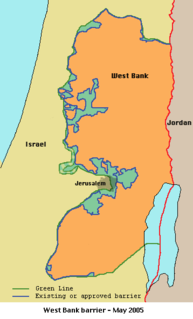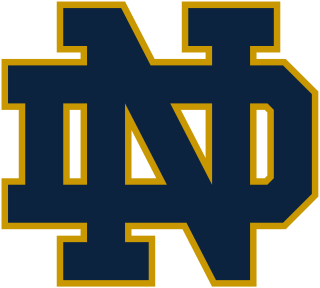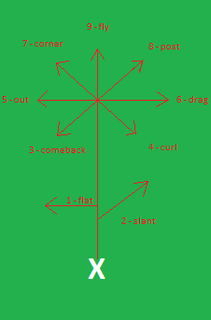Related Research Articles

A cornerback (CB) is a member of the defensive backfield or secondary in gridiron football. Cornerbacks cover receivers most of the time, but also blitz and defend against such offensive running plays as sweeps and reverses. They create turnovers through hard tackles, interceptions, and deflecting forward passes.

A linebacker is a playing position in gridiron football. Linebackers are members of the defensive team, and line up approximately three to five yards behind the line of scrimmage, behind the defensive linemen, and therefore "back up the line". The different responsibilities of outside linebackers in the 3–4 and 4–3 defenses usually lead to very different skill sets and body types being sought out by teams as to best fit their particular defenses. 3–4 OLBs are generally, or primarily required to play North to South, are lankier/taller, bulkier and stronger/more powerful as to effectively aid the ends in setting the edge on running plays and provide pressure to the quarterback on passing plays, and will usually have an arsenal of pass rush moves used primarily against the blockers the offense has on the edge of their line. 4–3 OLBs generally are expected to more proficiently move East to West more often and therefore are usually rangier players more adapt in covering potential receiving targets off the line or from the backfield, as well as having outside contain beyond the tackle box on run plays. Linebackers generally align themselves before the ball is snapped by standing upright in a "two-point stance".
In gridiron football, blitzing is a tactic used by the defense to disrupt pass attempts by the offense. During a blitz, a higher than usual number of defensive players will rush the opposing quarterback, in an attempt either to tackle him or force him to hurry his pass attempt.
Strategy forms a major part of American football. Both teams plan many aspects of their plays (offense) and response to plays (defense), such as what formations they take, who they put on the field, and the roles and instructions each player are given. Throughout a game, each team adapts to the other's apparent strengths and weaknesses, trying various approaches to outmaneuver or overpower their opponent in order to win the game.

John Harold Lambert is an American former professional football player who was a linebacker in the National Football League (NFL). Recognized by the Pro Football Hall of Fame in 1990 as "the greatest linebacker of his era," Lambert was the starting middle linebacker for four Super Bowl-winning teams during an 11-year career with the Pittsburgh Steelers.

The 46 defense is an American football defensive formation, an eight men in the box defense, with six players along the line of scrimmage. There are two players at linebacker depth playing linebacker technique, and then three defensive backs. The 46 defense was originally developed and popularized with the Chicago Bears by their defensive coordinator Buddy Ryan, who later became head coach of the Philadelphia Eagles and Arizona Cardinals.
Bump and run coverage is a strategy formerly widely used by defensive backs in American professional football in which a defender lined up directly in front of a wide receiver and tried to impede him with arms, hands, or entire body and disrupt his intended route. This originated in the American Football League in the 1960s, one of whose earliest experts was Willie Brown of the Oakland Raiders. Mel Blount of the Pittsburgh Steelers specialized in this coverage to such a point as to cause numerous rule changes strictly limiting when and where a defender may make contact with a potential receiver in order to make it easier for receivers to run their routes and increase scoring.
In American football, a zone blitz is a defensive tactic that sends additional players to rush the opposing team's quarterback, whilst also unexpectedly redirecting a supposed pass rushing player into pass coverage instead. This tactic also likely includes zone coverage.

The Tampa 2 is an American football defensive scheme popularized by the Tampa Bay Buccaneers National Football League (NFL) team in the mid-1990s–early 2000s. The Tampa 2 is typically employed out of a 4–3 defensive alignment, which consists of four linemen, three linebackers, two cornerbacks, and two safeties. The defense is similar to a Cover 2 defense, except the middle linebacker drops into a deep middle coverage for a Cover 3 when he reads a pass play.

In gridiron football double coverage is a state of defensive playcalling wherein two defensive players are assigned to "cover" one offensive player. This situation is often seen with standout wide receivers and running backs.

A post is a moderate to deep passing route in American football in which a receiver runs 10–20 yards from the line of scrimmage straight down the field, then cuts toward the middle of the field at a 45-degree angle.
In American football a play is a close to the ground "plan of action" or "strategy" used to move the ball down the field. A play begins at either the snap from the center or at kickoff. Most commonly plays occur at the snap during a down. These plays range from basic to very intricate. Football players keep a record of these plays in their playbook.

Seam Zone is a term used to refer to a land area in the Israeli-occupied West Bank located east of the Green Line and west of Israel's separation barrier, populated largely by Israelis in settlements such as Alfei Menashe, Ariel, Beit Arye, Modi'in Illit, Giv'at Ze'ev, Ma'ale Adumim, Beitar Illit and Efrat.

In American football, the 3–4 defense is a common defensive alignment consisting of three down linemen and four linebackers. It is a called a "base defense" because it is the default defensive alignment used on "base downs". However, defenses will readily switch to other defensive alignments as circumstances change. Alternatively, some defenses use a 4–3 defense.

Zone coverage is a defense scheme in gridiron football used to protect against the pass.

In American football, a 4–3 defense is a defensive alignment consisting of four down linemen and three linebackers. It is called a "base defense" because it is the default defensive alignment used on "base downs". However, defenses will readily switch to other defensive alignments as circumstances change. Alternatively, some defenses use a 3–4 defense.
The following terms are used in American football, both conventional and indoor. Some of these terms are also in use in Canadian football; for a list of terms unique to that code, see Glossary of Canadian football.
The flat in gridiron football is the area of the field extending ten yards into the defensive backfield from the line of scrimmage and extending outside the hash marks to the out-of-bounds lines.

The Notre Dame–Pittsburgh football rivalry is an American college football rivalry between the Notre Dame Fighting Irish and Pittsburgh Panthers.

A route is a pattern or path that a receiver in gridiron football runs to get open for a forward pass. Routes are usually run by wide receivers, running backs and tight ends, but other positions can act as a receiver given the play.
References
- ↑ "Playoff Anatomy: Saints' seam route".
- ↑ "Seam Route Definition - Sporting Charts".
- ↑ "Learning Seams And Soft Spots Against Zone Coverage - Football Tutorials". 10 October 2011.
- ↑ "Archived copy". Archived from the original on 2015-02-20. Retrieved 2015-02-23.CS1 maint: archived copy as title (link)
| This American football–related article is a stub. You can help Wikipedia by expanding it. |